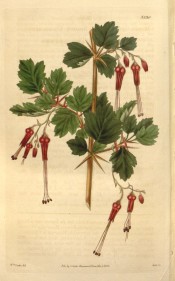Ribes speciosum Pursh
Fully hardy, upright, spiny, deciduous shrub with bristly shoots, red when young, ovate, 3- to 5-lobed leaves, to 4cm long, and small pendant racemes of slender, bell-shaped, dark red flowers in spring, followed by spherical, bristly red fruit. To 2m. [RHSE, Hortus, Hilliers’].
Horticultural & Botanical History
‘This fine Ribes, so remarkable for its leaves resembling those of the White-Thorn, and its flowers those of a Fuchsia, was first discovered by the venerable Menzies in California, during the voyage of Capt. Vancouver, and his beautiful drawing and description made on the spot, are now before me. It was introduced to our gardens by Mr. Collie, the surgeon of H. M. S. Blossom, in 1829. Our drawing was made by Mr. William Curtis, at the extensive Nursery Grounds of Glazenwood. In native specimens, the leaves are smaller, and the racemes only two-flowered. In England the plant seems to be perfectly hardy: in Scotland it requires the protection of a wall, or the flowers will effectually, in most years, be destroyed, by our fickle springs. Its flowering season is April and May; its growth is rapid and vigorous during summer, and the plant is now becoming common.’ [BM t.3530/1836]. OFG f.39/1854.
History at Camden Park
Listed in all published catalogues [T.831/1843].
Notes
Published Mar 27, 2010 - 04:32 PM | Last updated Mar 27, 2010 - 04:40 PM
| Family | Grossulariaceae |
|---|---|
| Category | |
| Region of origin | Western USA |
| Synonyms | |
| Common Name | Fuchsia-flowered currant, Fuchsia-flowered gooseberry |
| Name in the Camden Park Record |
Ribes speciosum - Scarlet flowered gooseberry |
| Confidence level | high |
